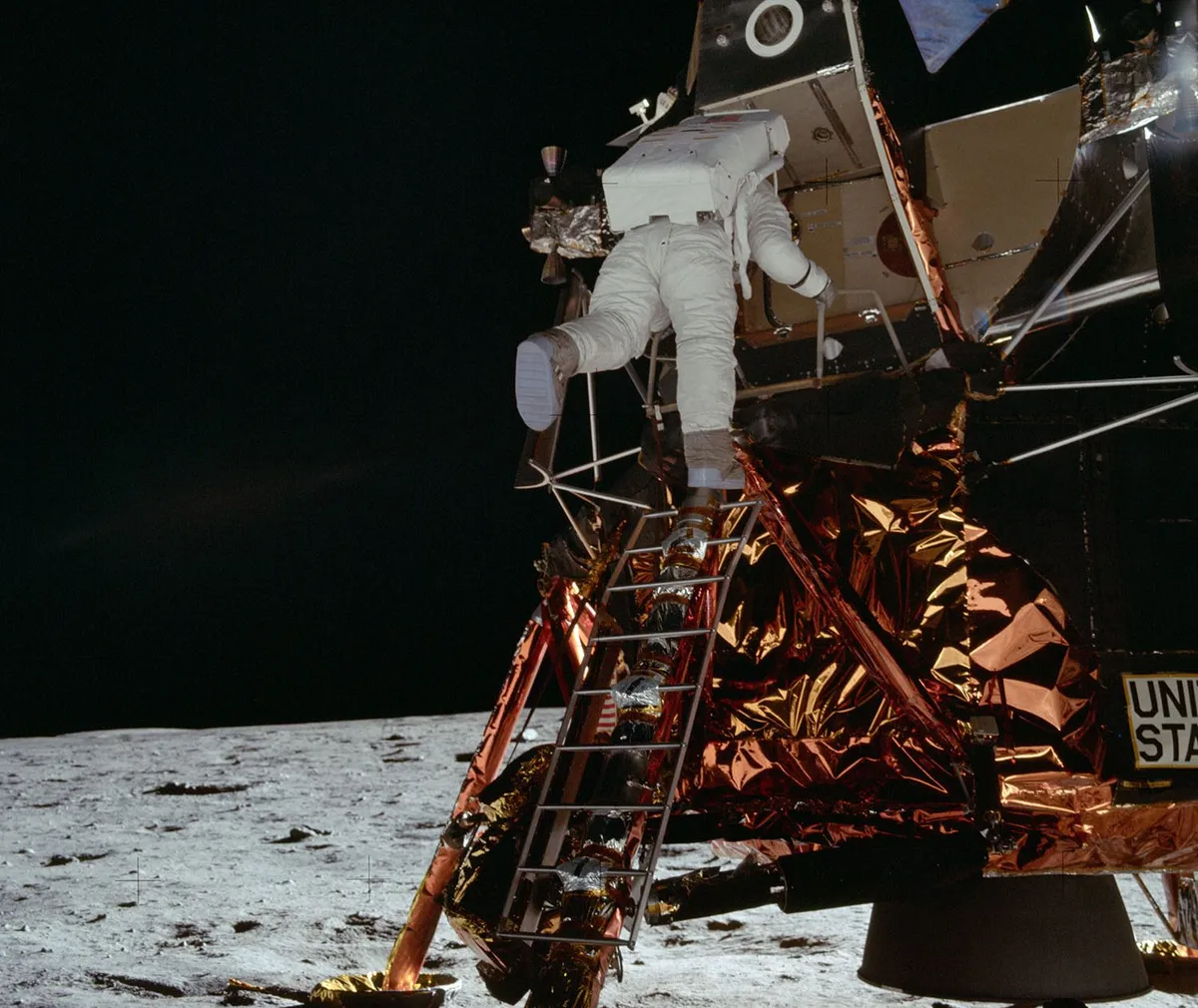BBC Television Centre, White City, London; sometime during the night of 4-5 July 1997. Patrick Moore marches into the room and straight up to the monitors the rest of us are clustered around, awaiting the results from the Mars Pathfinder mission.
“Ah, the sky is pink. Garry Hunt owes me a bottle of whisky!” he says.
This wager had originated some 21 years earlier during the Viking 1 mission to Mars. NASA released the first colour picture taken on the surface of the Red Planet on 21 July 1976 and it showed a blue sky.
Then, five days later, NASA released a recalibrated photo that showed the Martian sky to be, in fact, red.
Read more about Solar System exploration:
- Juno at Jupiter: a planetary scientist's perspective
- What did the Venus Express mission discover?
- How will humans survive the journey to Mars?
Ahead of the landing of Pathfinder on the Red Planet in 1997, Garry and Patrick made a bet on whether NASA would make the same mistake again. This time, however, NASA didn’t, and Patrick won the bet.
While the apparent presence of a blue sky on Mars surprised many people, it was the absence of another Martian feature that had astonished scientists during another mission to the planet 16 years prior to Viking 1. In 1965, images captured by Mariner 4 during the first successful flyby of the planet disproved the existence of the Martian canals that had been mistakenly identified by Giovanni Schiaparelli in 1877.

But for the lack of anything better, mission scientists were forced to use a Mars globe complete with canals to illustrate what the probe’s imaging sequence would be.
Hidden under white clouds, Venus remained even more a mystery than Mars. The discovery of its atmosphere by Mikhail Lomonosov in 1761 gave astronomers two full centuries to speculate on what may lie underneath. Predictions included a carboniferous world with dinosaurs and oceans of fizzy water.
But when Mariner 2 performed the first flyby of Venus in 1962, the results were devastating. The planet, it was discovered, took so long to rotate that any semblance of a diurnal pattern suitable for life would be impossible.
Worse still, the spacecraft found the conditions at the surface to be atrocious. Temperature and pressure ruled
out the possibility of life.
In 1955 Austrian astrophysicist Thomas Gold predicted that astronauts would sink without a trace should they attempt to land in the deep dust on the Moon’s surface.
The legacy of Gold’s prediction can be seen in the Apollo programme. The lunar module that carried Neil Armstrong and Buzz Aldrin to the surface of the Moon was built with the bottom rung of its ladder higher than necessary to compensate for any sinking that might occur.
As a result, Armstrong had to practise jumping from the module’s landing pad up to the bottom rung, just to make sure he could make it back on board before finally stepping onto the lunar surface.

It wasn’t just the composition of the surface that was cause for argument; the origin of lunar craters was an equally divisive matter.
Many believed they were the result of volcanism; it wasn’t until the 1960s that the impact origin for most craters was accepted.
The discovery of active volcanoes on Jupiter’s moon Io in 1979 was another milestone. They were found by Linda Morabito, a technician looking for stars in order to calibrate Voyager 1’s trajectory.
Io, like the other three Galilean moons, was presumed to be an icy world covered in craters, so when images showed a blotchy body that resembled a pizza, almost everyone was surprised.
But not Stanton Peale of the University of California or NASA’s Pat Cassen and Ray Reynolds.
Just one day before the surface of Io swam into view, the journal Science printed a paper by the trio who had been studying the orbits of Jupiter’s four biggest moons and noticed Io had been forced into an orbit that was slightly elliptical.
They predicted that resulting tidal heating would cause “widespread and recurrent surface volcanism”.
Tidal heating also seems to have affected the other Galilean satellites, so planetary scientists now had four new diverse worlds to explain.

The icy shell of Europa and the grooves of Ganymede brought glaciologists into the club of expertise now required to understand how the solid worlds of the Solar System formed.
The surprises at Jupiter meant the Voyager team were far more prepared for the twin spacecrafts’ encounters with the moons of Saturn.
Two in particular were of great interest: Enceladus and Titan. While Enceladus looked like a mini-Europa, the large moon Titan, with its thick atmosphere, blocked any view of the surface from Voyager 1.
The showcase of Voyager 2’s final pit stop at Neptune has to be the moon Triton. Pre-encounter telescope studies had found absorption lines in Triton’s spectrum that were interpreted as nitrogen – quite probably in liquid form.
Ultimately Triton’s nitrogen seas turned out to be solid, but the discovery of active cryovolcanism in the form of geysers marked only the second time activity had been seen on another world.
The 1990s saw spacecraft return to Venus, Mars and Jupiter. Selecting what is included on a planetary spacecraft is a predictive process; however, errors can and still do occur.
In 1997 Mars Pathfinder deployed the Sojourner rover, equipped with an alpha particle X-ray spectrometer to perform close up analyses of individual rocks.
Many of the results were “contaminated by dust adhering to the rock’s surface”. Dust? On Mars? The Mars Curiosity rover, which landed in August 2012, included a dust brush.
Today the long arguments over the results from the Magellan Venus mapper are finally over. Twenty years of theory and analysis had failed to establish whether or not there was volcanism on Venus.
But thanks to Venus Express, the disputes were finally put to rest in 2015. Being so similar in size and density to Earth, Venus was assumed to be volcanically active by many, but the data from impact crater distribution said otherwise: a reminder of the dangers of assuming too much when predicting what another world will look like.

Since the Voyager missions Titan has received some proper attention too. The Huygens lander was the first probe designed to land on a solid or liquid surface.
Seas of ethane and methane were likely but only a theory. Spare a thought, then, for the graduate students at the University of Kent who built parts of Huygens’s Surface Science Package.
The lander incorporated a penetrometer to measure properties of any solid surface, as well as a buoyancy sensor to measure any liquid it landed in.
The creators of these instruments knew only one of them would be getting results. Now that we have infrared maps of liquid hydrocarbon lakes on Titan’s surface, the next lander will not have to carry both instruments.
The discovery of liquid water on the surface of Mars isn’t surprising to anyone who has followed Martian exploration.
Ice at the poles of the Moon and Mercury were successfully predicted. We now have activity on Venus, Earth, Io, Europa, Enceladus and Triton.
Those who predicted nothing but impact craters in the outer Solar System are mostly retired. We will pretend not to remember that the Voyager team originally had just one geologist.
One of the next big predictions is that of Europa’s subsurface ocean. Planetary scientists are pretty certain this exists, but is it global or are there separate bodies of salty water down there?
If it is global, then the crust is decoupled from the mantle and could allow for non-synchronous rotation.
To be safe, the only prediction I will make is that the Solar System will only become more amazing the more we explore it.
Dave Hawksett is an amateur astronomer and the contributing science consultant for Guinness World Records. This article originally appeared in the January 2016 issue of BBC Sky at Night Magazine.
